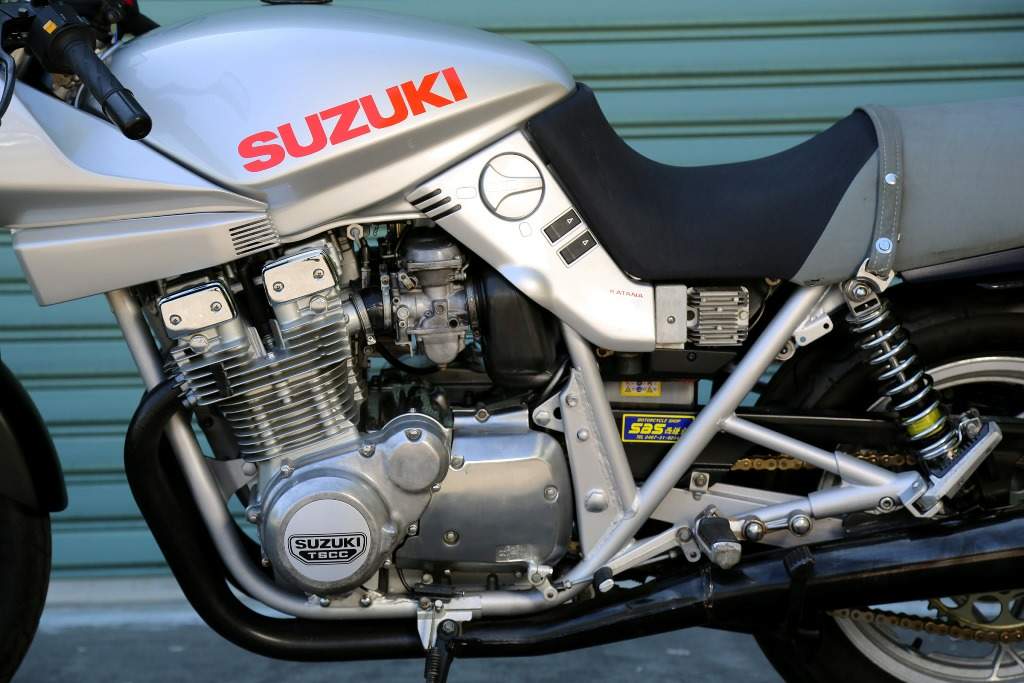
|
|
|
|
|
|
Classic Bikes
Custom Bikes
Individual
Racing Bikes AJP
AJS
Aprilia
Ariel
Avinton / Wakan
Bajaj
Benelli
Beta
Bimota
BMW
Brough Superior
BRP Cam-Am
BSA
Buell / EBR
Bultaco
Cagiva
Campagna
CCM
CF Moto
Combat Motors
Derbi
Deus
Ducati
Excelsior
GASGAS
Ghezzi Brian
Gilera
GIMA
Harley Davidson
Hero
Highland
Honda
Horex
Husaberg
Husqvarna
Hyosung
Indian
Jawa
Kawasaki
KTM
KYMCO
Laverda
Lazareth
Magni
Maico
Mash
Matchless
Mondial
Moto Guzzi
Moto Morini
MV Agusta
MZ / MuZ
NCR
Norton
NSU
Paton
Peugeot
Piaggio
Revival Cycles
Roland Sands
Royal Enfield
Sachs
Sherco
Sunbeam
Suzuki
SWM
SYM
Triumph
TVS
Ural
Velocette
Vespa
Victory
Vincent
VOR
Voxan
Vyrus
Walt Siegl
Walz
Wrenchmonkees
Wunderlich
XTR / Radical
Yamaha
Zero
Video
Technical
Complete Manufacturer List
|
Suzuki GSX 1100S Katana

The Suzuki Motor Company
was born in 1920. To celebrate its 70th birthday, what better than offering
the Japanese public the bike they could never have: the original Katana? The
"70th Anniversary" is practically the 1981 produced in 1000 units. These
will all be sold on the launch day! This highly successful formula – Which took Suzuki by surprise – or did it ? – demonstrates the potential of a second edition that will be launched in September 1990. The GSX1100SSL will receive the duotone scheme of the 1984SE version. History
The katana is the most popular among the samurai swords, warriors
in the service of the feudal lords in medieval Japan.
It had a long curved blade for cutting single and could be challenged with one
or both hands.
The suspension system is formed by a telescopic hydraulic front fork 35 mm, with anti-dive and anti-dive with screw spring preload on four positions, which is accessed by removing the rubber plugs on the head of the fork; posteriorly there is a swingarm arm with two adjustable hydraulic shock absorbers of five positions of spring preload and four hydraulic extension. The front brake is a double perforated disc 275 mm with single piston calipers that "bite" promptly, the rear brake with tank with viewing window to check the oil level, it is a disk with a hole the same size of the front , with a single piston caliper, equipped with a door for the replacement of the pads.
The wheels are 5-spoke alloy stellar: the front measurement from 1.85 to 19, the
rear 2.5-17. The driving position forced the pilot, with the torso leaning forward and rearsets, to pass on to his front weight on the wrists. The angle of the handlebar into two pieces was a little hit and did nothing but penalize the forearms of the same, especially in city traffic. In the front and rear of the motorcycle, stood the big and ugly direction indicators and the size of the 4-cylinder, deliberately left out the essential forms much of the body, whose appearance, decidedly unusual, it was designed by the German Target Design. Currently, this futuristic motion of the Rising Sun is a success among fans and collectors from around the world and remains an interesting piece of motorcycling history post-classic. It would be well, however, to preserve it from the dangers of the time, for it has always played a very particular role and not always positive.
|
|
|
Any corrections or more information on these motorcycles will be kindly appreciated. |